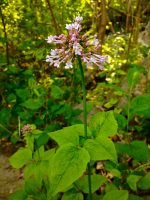 This herbaceous perennial is native to Eastern US from Pennsylvania west to Illinois and south to include Maryland, Tennessee and West Virginia, Kentucky and Alabama where it grows in moist shady habitats such as woodlands, river valleys, flood plains and along streams. It is a member of the honeysuckle family, Caprifoliaceae, that also includes weigelia, abelia, and twinflower. Plants grow 1.5-6′ tall from a fibrous root system occasionally with rhizomes or stolons, and produce basal heart-shaped leaves that are sometimes divided into to 2 lateral leaflets and a larger terminal leaflet. The stems are mostly unbranched and carry opposite pairs of odd-pinnate leaves with 3-7 oval sessile leaflets that are up to 8″ long. From late spring to early summer, terminal panicles of white to light pink flowers appear. Each funnelform flower is 1/2-3/4″ long and has 3 exerted stamens. Additional smaller panicles may appear in the axils of the upper leaves. The fruit is a plumed achene. Large flower valerian is sutable for a rain garden, wildflower garden, and native plant garden. The genus name, Valeriana, is a medieval Latin name possibly derived from the Latin word valere, meaning to be healthy, referring to the plants’ use to cure nervousness and hysteria. The specific epithet, pauciflora, comes from the Latin words, paucus meaning few, and flos, meaning flower and refers to the amount of flowers in a cluster.
This herbaceous perennial is native to Eastern US from Pennsylvania west to Illinois and south to include Maryland, Tennessee and West Virginia, Kentucky and Alabama where it grows in moist shady habitats such as woodlands, river valleys, flood plains and along streams. It is a member of the honeysuckle family, Caprifoliaceae, that also includes weigelia, abelia, and twinflower. Plants grow 1.5-6′ tall from a fibrous root system occasionally with rhizomes or stolons, and produce basal heart-shaped leaves that are sometimes divided into to 2 lateral leaflets and a larger terminal leaflet. The stems are mostly unbranched and carry opposite pairs of odd-pinnate leaves with 3-7 oval sessile leaflets that are up to 8″ long. From late spring to early summer, terminal panicles of white to light pink flowers appear. Each funnelform flower is 1/2-3/4″ long and has 3 exerted stamens. Additional smaller panicles may appear in the axils of the upper leaves. The fruit is a plumed achene. Large flower valerian is sutable for a rain garden, wildflower garden, and native plant garden. The genus name, Valeriana, is a medieval Latin name possibly derived from the Latin word valere, meaning to be healthy, referring to the plants’ use to cure nervousness and hysteria. The specific epithet, pauciflora, comes from the Latin words, paucus meaning few, and flos, meaning flower and refers to the amount of flowers in a cluster.
Type: Herbaceous perennial
Bloom: Panicles of funnelform light pink or white flowers with 3 exerted stamens from late spring to early summer
Size:1.5-6′ H
Light: Part shade to part sun
Soil: Fertile, medium moist, well-drained
Hardiness: Zones 4-9
Care: Low maintenance
Pests and Diseases: None os signficance
Propagation: Seed, division
Companion Plants: Cinnamon fern, wild bergamot, nine bark, arrow wood
Photo Credit: Wikipedia